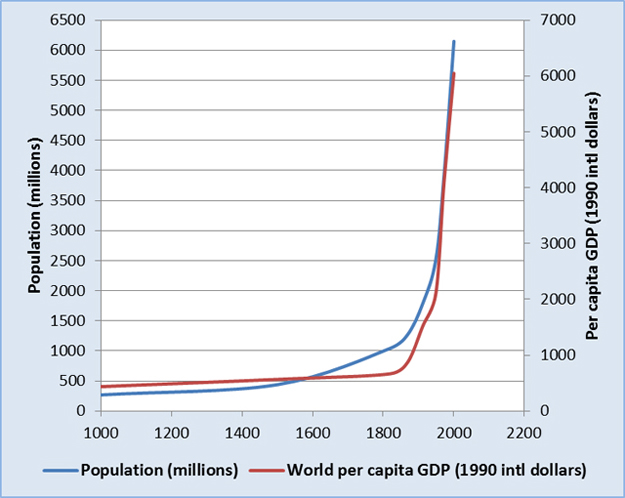

Since the total sum of incomes is the total sum of production this also means that the production of the average person in two weeks today is equivalent to the production of the average person in an entire year in the past. This means an average person in the UK today has a higher income in two weeks than an average person in the past had in an entire year. The second part is much shorter, it encompasses only the last few generations and is radically different from the first part, it is a time in which the income of the average person grew immensely – from an average of £1051 incomes per person per year increased to over £30,000 a 29-fold increase in prosperity. Average incomes (as measured by GDP per capita) in England between the year 12 were £1,051 when measured in today’s prices. Almost all that ordinary people used and consumed in the 17th century would have been very familiar to people living a thousand or even a couple of thousand years earlier. What people used as shelter, food, clothing, energy supply, their light source stayed very similar for a very long time. Incomes remained almost unchanged over a period of several centuries when compared to the increase in incomes over the last 2 centuries. The first part is the very long time in which the average person was very poor and human societies achieved no economic growth to change this. The chart below shows the reconstructed GDP per capita in England and the UK over the last 7 centuries.Įconomic history is a very simple story.

Self-reported life satisfaction vs GDP per capita.Price level relative to the US vs GDP per capita.Output of key service and industrial sectors in England and the UK.Output of key industrial sectors in England and the UK.Nominal wages, consumer prices, and real wages in the UK.Labor force participation rate of men, 65 years and older in the USA.Historical Index of Human Development with GDP metric vs.Historical Index of Human Development vs.Historical Index of Human Development (without GDP metric) vs.Growth rate of real GDP per employed person.Gross domestic product (GDP) World Bank.GDP per capita from the World Bank vs.GDP per capita (inflation- and PPP-adjusted): World Bank data vs.GDP per capita Maddison (2020) - line chart.GDP per capita Maddison Project Database 2020 (map).GDP Maddison 2020 world regions stacked area.Composition of national gross domestic product by sector.CO₂ emissions per capita vs GDP per capita.Average GDP growth rate 1960-2011 versus GDP per capita in 1960.Access to a financial account or services.In this entry we will also look at this more recent time and will also study the inequality between different regions – both in respect to the unequal levels of prosperity today and the unequal economic starting points for leaving the poverty of the pre-growth past. Comparisons over time and across borders are complicated by price, quality and currency differences, as explained below.įrom the long-term perspective of social history, we know that economic prosperity and lasting economic growth is a very recent achievement for humanity. More precisely, it is the monetary value of all final goods and services produced within a country or region in a specific time period. The Gross Domestic Product (GDP) of an economy is a measure of total production. Income measures are merely one way to understand the economic inequality between countries and the changing prosperity over time. Growth is often measured as an increase in household income or inflation-adjusted GDP, but it is important to keep in mind that this is not the definition of it – just like life expectancy is a measure of population health, but certainly not the definition of population health. While the definition of economic growth is straightforward, it is extremely difficult to measure it. Economic growth describes an increase in the quantity and quality of the economic goods and services that a society produces and consumes.


 0 kommentar(er)
0 kommentar(er)
